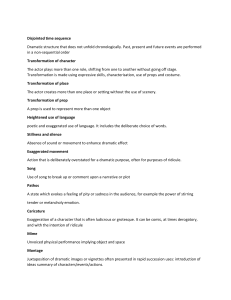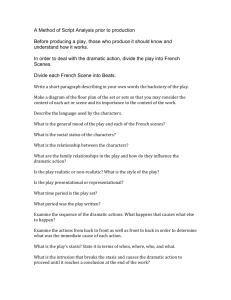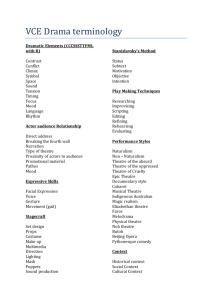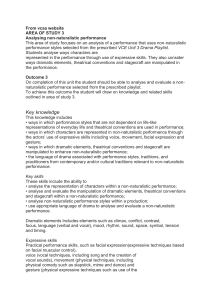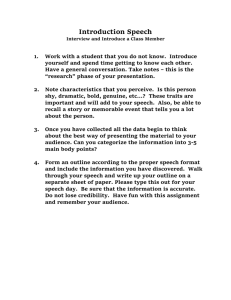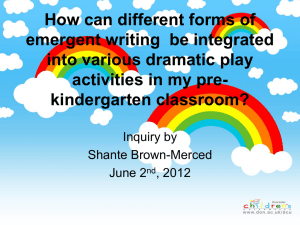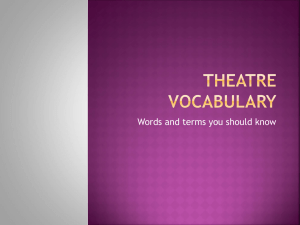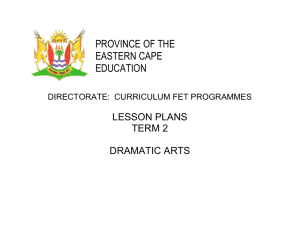THEATRICAL CONVENTIONS PLAY
advertisement
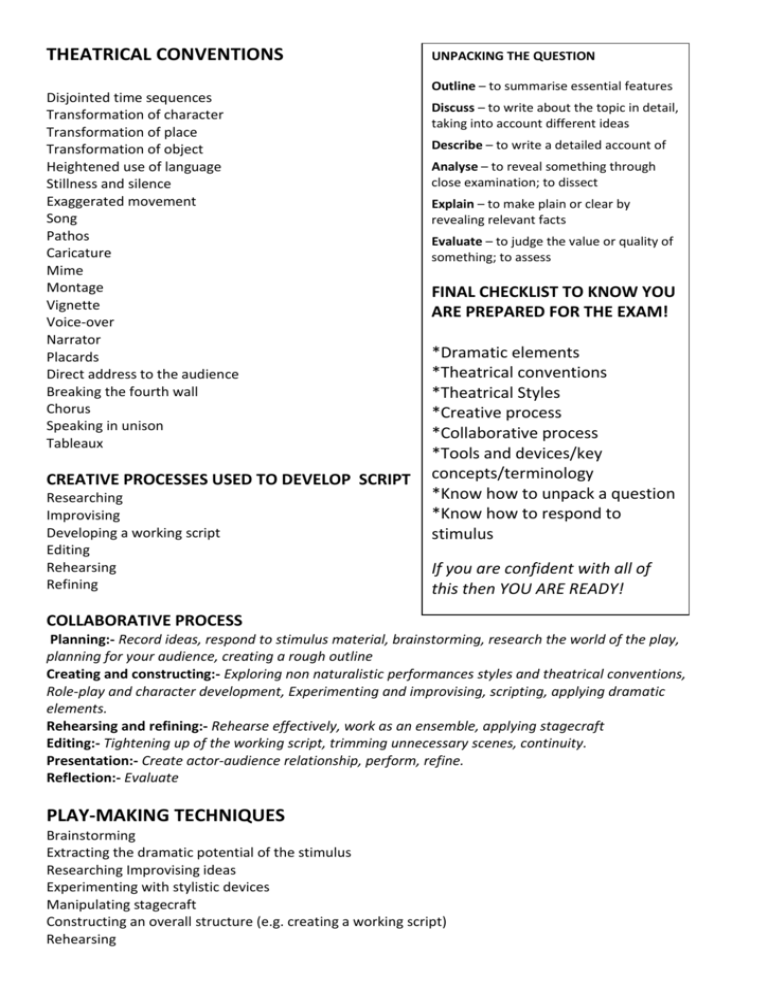
THEATRICAL CONVENTIONS Disjointed time sequences Transformation of character Transformation of place Transformation of object Heightened use of language Stillness and silence Exaggerated movement Song Pathos Caricature Mime Montage Vignette Voice-over Narrator Placards Direct address to the audience Breaking the fourth wall Chorus Speaking in unison Tableaux CREATIVE PROCESSES USED TO DEVELOP SCRIPT Researching Improvising Developing a working script Editing Rehearsing Refining UNPACKING THE QUESTION Outline – to summarise essential features Discuss – to write about the topic in detail, taking into account different ideas Describe – to write a detailed account of Analyse – to reveal something through close examination; to dissect Explain – to make plain or clear by revealing relevant facts Evaluate – to judge the value or quality of something; to assess FINAL CHECKLIST TO KNOW YOU ARE PREPARED FOR THE EXAM! *Dramatic elements *Theatrical conventions *Theatrical Styles *Creative process *Collaborative process *Tools and devices/key concepts/terminology *Know how to unpack a question *Know how to respond to stimulus If you are confident with all of this then YOU ARE READY! COLLABORATIVE PROCESS Planning:- Record ideas, respond to stimulus material, brainstorming, research the world of the play, planning for your audience, creating a rough outline Creating and constructing:- Exploring non naturalistic performances styles and theatrical conventions, Role-play and character development, Experimenting and improvising, scripting, applying dramatic elements. Rehearsing and refining:- Rehearse effectively, work as an ensemble, applying stagecraft Editing:- Tightening up of the working script, trimming unnecessary scenes, continuity. Presentation:- Create actor-audience relationship, perform, refine. Reflection:- Evaluate PLAY-MAKING TECHNIQUES Brainstorming Extracting the dramatic potential of the stimulus Researching Improvising ideas Experimenting with stylistic devices Manipulating stagecraft Constructing an overall structure (e.g. creating a working script) Rehearsing …MORE PLAY-MAKING TECHNIQUES Blocking Character/role development exercises (e.g. hot seating, visualisation, character workshops) Role-play Scripting Editing Refining Reflecting GENERAL TERMINOLOGY Non-naturalistic This term is a broad category for all performance styles that are not dependent on the lifelike representation of everyday life. Non-naturalistic performance styles are not dependent on naturalistic characteristics to establish meaning. In non-naturalistic performance, the actor does not attempt to recreate, on the stage, life as it is lived. Non-naturalistic performance is characterised by a manipulation of character, time, place and object as well as the narrative elements of the drama. Create To enact for an audience situations and conversations that may be informed by material other than the stimulus, such as reference material. The emphasis in the creation must be on action rather than narration – doing rather than telling. Re-create To re-enact situations and conversations which are informed by the stimulus. The emphasis in the recreation must be on action rather than narration – doing rather than telling. Caricature Caricature is an exaggeration of a character that is often ludicrous or grotesque. It can be comic, at times derogatory, and with the intention of ridicule. Climax The moment of highest dramatic tension in a performance when things change, or reach a crisis point, and may lead to a resolution. Commedia dell’arte A form of theatre characterised by masked ‘types’ or stock characters, high energy performance, and often includes basic plots, pantomimic acting, buffoonery, juggling and acrobatic feats. Conflict A struggle within a character and/or between characters. Conflict may be between a character and some obstacle. Contrast Highlight differences through the juxtaposition of dramatic action and sound. Disjointed time sequences Dramatic structure that does not unfold chronologically. Past, present and future events in the plot are performed in a non-sequential order. Dramatic metaphor The endowment of a word, object or feeling with an intensity of meaning other than the literal. Emphasis is on isolating specifics within the performance that best provide an enhancement of meaning for the work, or at least indicate the complexity of the intended meaning. Elizabethan theatre Notable conventions of this style of theatre included blank verse using iambic pentameter, the play-within a-play, the soliloquy, the aside and the masque. Acting was stylised and gestured. The actors, known as ‘players’, often wore contemporary Elizabethan dress. Fixed scenery was minimal. The players relied more on easily portable props. Exaggerated movement Exaggerated movement includes action that is overstated, drawn larger than life, often for the purposes of ridicule. Freeze frame A freeze frame is a frozen moment of a scene. During a performance the actor freezes action and sound at a premeditated time to enhance dramatic tension and/or to highlight an important moment in a scene. It can be compared to pressing ‘pause’ on a video at a significant moment in the narrative. Heightened use of language Heightened use of language is poetic and exaggerated use of language. It includes the deliberate choice of words whose syntax, alliteration and rhyming patterns enhance the dramatic statement. Intended meaning is enhanced through the use of non-conventional and non-naturalistic dialogue. Montage In contemporary theatre a montage is a juxtaposition of dramatic images, often presented in rapid succession. The dramatic images are closely linked and presented to create an overall impression, and/or a summary of events/actions, and/or an introduction to events/actions. Mood The emotional feeling created in a performance. Pathos Pathos is a state which evokes a feeling of pity or sadness in the audience; for example, the power of stirring tender or melancholy emotion. Pathos may be associated with comedy and tragedy. Parable A short allegorical story designed to illustrate or teach some truth, principle or moral lesson. Rhythm A regular pattern of sounds, words or actions. Satire The use of wit and comedy to attack, denounce or deride a target. Satire exposes or questions the presence of vice, folly, abuse or pretence. It can be achieved through the manipulation of language, caricature, parody, parable or other comedic theatrical conventions. The satirist laughs at, punishes or questions a target and/or an audience. The target may be an individual or a system. Stillness and silence To be found where there is an absence of sound and absence of movement – used to enhance dramatic effect. Sound The use of voice, recorded/live music or noise in order to create an effect or aural accompaniment to action. Symbol Something that suggests something else. Actors may use a prop symbolically or may make a symbolic gesture with their body or voice. Transformation of character The actor manipulates expressive skills to create characters in performance. A change in character therefore requires modification of the focus and manner of use of expressive skills by the actor. Additions of mask or costume may enhance the character transformation but does not constitute transformation unless accompanied by communicable changes in the use of expressive skills. Transformation of object An object(s) is endowed with a variety of meanings by the actor. Transformation of place The actor creates more than one place or setting during the performance and does so without the use of scenery. The actor can communicate transformation of place to an audience through the context they create for the performance and through the use of objects and space in symbolic ways. Transformation of place can be achieved through the transformation of properties (real and imagined) and/or through the use of expressive skills alone.
